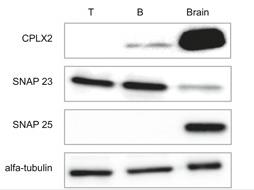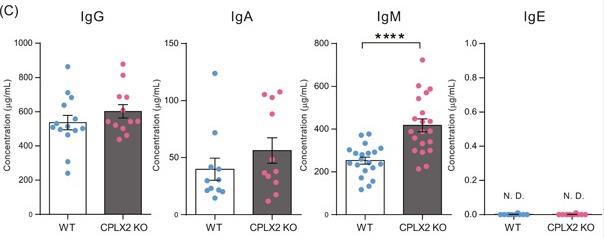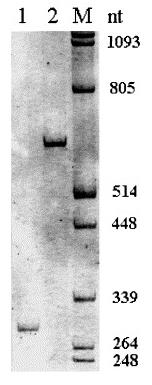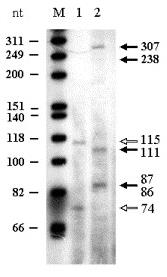Recombinant Human CPLX2 protein(Asp2-Lys134), His-tagged
| Cat.No. : | CPLX2-3941H |
| Product Overview : | Recombinant Human CPLX2 (Q6PUV4-1) (Asp 2-Lys 134) was expressed in E. coli, with a polyhistide tag at the N-terminus. |
- Specification
- Gene Information
- Related Products
- Case Study
- Application
- Download
| Species : | Human |
| Source : | E.coli |
| Tag : | His |
| Protein Length : | 2-134 a.a. |
| Form : | Lyophilized from sterile PBS, pH 7.4. Normally 5 % - 8 % trehalose, mannitol and 0.01% Tween80 are added as protectants before lyophilization. |
| Molecular Mass : | The recombinant human CPLX2 consists of 144 amino acids and has a calculated molecular mass of 16.8 kDa. It migrates as an 21 kDa band in SDS-PAGE under reducing conditions. |
| Purity : | > 90 % as determined by SDS-PAGE |
| Storage : | Samples are stable for up to twelve months from date of receipt at -20°C to -80°C. Store it under sterile conditions at -20°C to -80°C. It is recommended that the protein be aliquoted for optimal storage. Avoid repeated freeze-thaw cycles. |
| Reconstitution : | It is recommended that sterile water be added to the vial to prepare a stock solution of 0.2 ug/ul. Centrifuge the vial at 4°C before opening to recover the entire contents. |
| Gene Name | CPLX2 complexin 2 [ Homo sapiens ] |
| Official Symbol | CPLX2 |
| Synonyms | CPLX2; complexin 2; complexin-2; CPX 2; DKFZp547D155; CPX II; synaphin 1; synaphin-1; complexin II; CPX2; Hfb1; 921-L; CPX-2; MGC138492; |
| Gene ID | 10814 |
| mRNA Refseq | NM_001008220 |
| Protein Refseq | NP_001008221 |
| MIM | 605033 |
| UniProt ID | Q6PUV4 |
| ◆ Recombinant Proteins | ||
| CPLX2-7849Z | Recombinant Zebrafish CPLX2 | +Inquiry |
| CPLX2-1224R | Recombinant Rat CPLX2 Protein, His (Fc)-Avi-tagged | +Inquiry |
| CPLX2-5683H | Recombinant Human CPLX2 Protein, Myc/DDK-tagged, C13 and N15-labeled | +Inquiry |
| CPLX2-2075HF | Recombinant Full Length Human CPLX2 Protein, GST-tagged | +Inquiry |
| Cplx2-934M | Recombinant Mouse Cplx2 Protein, MYC/DDK-tagged | +Inquiry |
| ◆ Cell & Tissue Lysates | ||
| CPLX2-7312HCL | Recombinant Human CPLX2 293 Cell Lysate | +Inquiry |
Case 1: Tsuru E, et al. Immun Inflamm Dis. 2019
Initially found in neurons, Complexins (CPLXs) help regulate vesicle fusion with cell membranes. While CPLX function in neurons is understood, their role in immune cells isn't clear. In our study, CPLX2 was seen in B cells but not T cells. Researchers explored this using CPLX2 knockout (KO) mice. We found that IgM, mostly natural antibodies, was higher in KO mice than in wild-types, though other antibodies stayed the same. Also, CPLX2 KO mice showed more IgM and IgG1 secretion from spleen cells, highlighting CPLX2's role in B cell function.

Fig1. Western blot analyses show protein expression levels of CPLX2, SNAP23, and SNAP25 in T and B cells.

Fig2. Concentrations of serum immunoglobulin G (IgG), IgA, and IgE in WT and CPLX2 KO mice were measured by ELISA.
Case 2: Raevskaya NM, et al. Gene. 2005
This study dives into the organization of the human complexin 2 (CPLX2) gene, which makes a 134-amino-acid protein. Located on chromosome 5q35.3, CPLX2 stretches over 87 kb and includes five exons. We discovered an alternate gene transcript variant with a changed 5' UTR but the same coding sequence. This variant lacks exons I and II, replacing them with exon A from intron 2. Using RT-PCR, we found both transcript types in human brain mRNA. The findings suggest two TATA-less promoters manage these transcripts, with expression varying across brain regions. This gene's structure is conserved in humans and rodents.

Fig1. Products specific to CPLX2_v2 (lane 1, primers F7/R6, lane 2, primers F8/R7).

Fig2. Low-resolution electrophoresis of human CPLX2 gene transcription start sites.
Not For Human Consumption!
Inquiry
- Reviews
- Q&As
Ask a Question for All CPLX2 Products
Required fields are marked with *
My Review for All CPLX2 Products
Required fields are marked with *
Inquiry Basket


